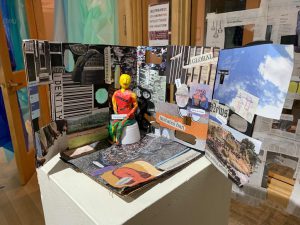The idea for this project originally came out of a Geography course we took in Fall 2018, taught by Professor Serin Houston. The course, entitled Global Movements, focused on migrations, global movements, refugees, and diasporas. One of our course assignments required us to draw upon our creativity and engage with a concept, topic, or theme relevant to the course. It was through this that our idea for an interactive art installation emerged.

Our original model served as a miniature design plan for how we might utilize a space to replicate the effects of the frames in the smaller model. Our final product was vastly different from our initial model created in November 2018, but the difference between the model and our art installation highlights the ways in which our engagement with the themes of home and identity have changed and shifted over the months we spent building the final art installation. In the end, the original tiny model became a part of our larger art installation to showcase that very growth and act as a meta-frame.
Our entire installation is made possible through various interactions throughout campus, and the resources we received from them. A significant part of our reflective process throughout this installation was acknowledging the limitations, boundaries, and possibilities created by the specific items we used and had access to. We mainly used recycled items and resources that we came in contact with due to our privilege of being at Mount Holyoke, and having access to the resources of this space. The process of having to work mostly with those materials allowed us to actively engage in questions of access and knowledge. We reflected and continue to reflect on: which information and knowledge we have access to; how we produce our own knowledge base through those limited and specific interactions; how we disseminate information and knowledge; who can access our project and how.
We also wanted to center collaboration and include perspectives that were not just our own. From this grew our BOOM workshop, where participants were invited to create collages. The participants also had the option to allow us to include their collage within our installation. The workshop consisted of a discussion, some activities, and crafting.
Both of us have grown a lot from this experience. Not only have we reflected a lot on our own perspectives surrounding these themes, we also had the opportunity to hear about other perspectives. We learned how to apply for grants, source materials, and run a workshop. We also learned to be flexible with our plan. The initial image we had in our head was completely different from how the installation turned out. Despite the twists, turns, logistical difficulties, and unexpected hurdles, we could not be prouder of what our installation turned out to be.
Another valuable lesson we learned was how many people are needed to bring such a project to life. We drew from many different departments, people, and resources over the course of this project. Among other things, this installation is indicative of the power of collaboration. On that note, we have a list of acknowledgments below. Hopefully, this list will give you an idea of how many different places our project emerged from.
We would like to thank:
- Professor Houston, for her invaluable guidance and willingness to help us make our ideas into reality. Without her, this project would not have had the support and wisdom needed to see it through
- The Inclusiveness Initiative Fund, which gave us the grant enabling our project to expand in unforeseen ways
- Sylvia Freifeld, whose friendship and kindness has seen this project through
- The members of the Mount Holyoke Community who participated in our BOOM workshop
- Our friends and mentors who came to our opening and showed their support
We would also like to thank:
- Professor Ligia Bouton, whose invaluable advice and experiences helped us consider the feasibility of our ideas, and ways to incorporate existing Mount Holyoke resources into our project
- Media Services and the LITS Circulation Desk, without whom the use of the projector, laptop, and cables would not have been possible
- Shani Mensing and the Fimbel Lab, who kindly hosted our BOOM workshop, and welcomed us to use their space
- Vice President Kijua Sanders-McMurtry, who allowed us to be a part of the BOOM conference, and advised us on running a workshop
- Deb and the Geography Department, who provided invaluable logistical assistance, supplies, and endless support
- Professor Rachel Fink, who provided some of our more organic supplies (such as our sea urchin skeletons, silkworm cocoon, and anise seed)
- The MHC Greenhouse and Professor Gina Siepel, both of whom gave us supplies, inspiration, and encouragement
- Facilities Management, who was so willing to work with us
- The Student Art Board, who allowed us to use the space
